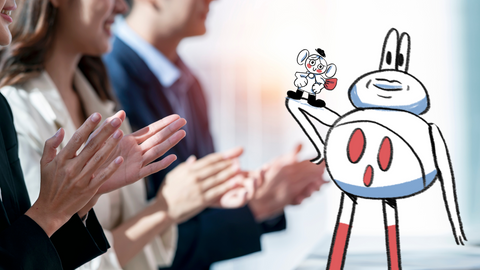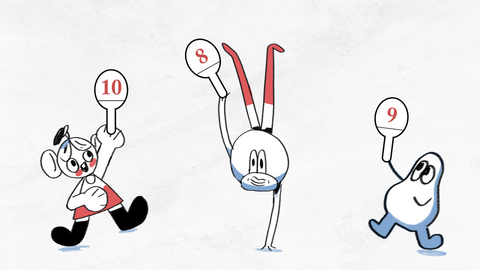Aspire to be more than ‘that person who runs product design workshops’.
Be 'that person who runs great product design workshops'.
As with most skills, practice is what truly makes perfect. But it helps if you’re practising the right things! So let’s explore how to elevate your craft.
What makes a great product design workshop?
There are three key elements that make for a great product design workshop:
- A clear objective
- Engaging, effective activities
- Room for creativity
The objective… well, how will you know if your workshop is ‘good’ or ‘successful’ if you don’t know what you’re aiming for? Even if you run the same meeting at the same time every week (or perhaps especially if you do!) you should set an objective.
The activities need to be effective at achieving that goal, and they need to be engaging to ensure you get the best out of the people in attendance. Sounds like a lot of planning, right? Well, yes - but there are shortcuts you can take! For example, using Workshop Tactics to choose the right activities (they are all designed to be engaging, and effective!).
But the final element requires you to not overplan things. Leave time in the agenda for playfulness, creativity and ‘what if’ thinking. Ensure a strong culture of psychological safety, too.
These three elements are foundational. But you also need to ensure you’ve got the right people in the room (more on that later) and the right environment.
Types of product design workshop
You’ll recognise different standardised types of product design workshops that occur throughout the product lifecycle. For example:
- Discovery workshop
- UX design workshop
- Ideation workshop
- Prototype workshop
What makes a great product design workshop is, surprisingly, largely the same regardless of which type of workshop you want to do. Great workshops are well planned, have the right people in the room and include activities that are tailored to help you achieve your objectives. You can find out more about how to choose those activities in the ‘Decide on your product design workshop format’ below.
Planning a great product design workshop
Plan who to invite to your design workshop
Answer these questions for each potential attendee:
- What are they bringing to the workshop?
- What will they take away from the workshop?
If the answer to both is ‘nothing’ (or nothing unique), they may be better off receiving a copy of the minutes instead. If you can only think of a solid answer for one of the two, consider whether they might be able to contribute in advance, or - again - receive the minutes, instead of attending.
That said, it’s absolutely fine if the ‘thing’ they bring is something that feels vague, like a unique perspective! Creativity can’t always be explained in concrete terms; just make sure no one will be wasting time by being there.
Decide on your product design workshop format
This is where you want to choose your objective, if you don’t already know what it should be. Ask yourself: if the team achieved nothing else at all, what would have the most impact? Use the Workshop Strategy System to find the right format to achieve that goal.
Once you know which tactic(s) you will use, play the session through in your head or on paper. That will help you answer some more important questions:
- Do you need a co-facilitator?
- Do you want someone to write minutes for some or all of it?
- What do attendees need to know in advance?
Prepare the materials for your design workshop
This includes the agenda - which can be crucial for getting the right people to agree to joining the session! We’ve got some tips for writing a razor-sharp agenda that gets people in the right frame of mind before they’re even in the room.
If you did a mental run-through of the session, you’ll know what’s required for each step of the process. Make a list of everything you’ll need (sticky notes, pens etc) or, if it’s a virtual session, set up your Miro board (or whatever platform you’ll use) in advance.
Now, you’re ready to go!
After your product design workshop
Success! You’ve completed the session and achieved your objectives. But wait - there’s still more value you can wring out of having had all those people together in the same room.
Reach out by email to thank everyone for coming. Share the minutes, if there are any, and actions. Then, ask for some of that all important information that will help you do even better next time: feedback.
Gather feedback about your product design workshop
If it’s a regular meeting you can keep it short and sweet. Ask people what they found most useful and what they would change if they had the opportunity. If it’s a one-off or a milestone session, you can dive a little deeper (find out more about how to gather workshop feedback, with example questions).
Make sure you’ve got a mechanism in place to record, monitor and act upon this feedback and any changes over time. You might find that a really energising workshop format loses its shine after being used every week for two months, or that having different people in the room affects the ‘vibe’. It’s all important information!
Review the value of your product design workshop(s)
At the end of a period of work, run a retrospective to review the value that your workshops have brought. Or, if it’s a one-off session, run a 'quick return on time invested' (ROTI) survey at the end. Ask every participant to answer the following question:
Was this product design workshop worth my time?
- Not at all - it was a complete waste of my time.
- Not really - it was useful, but not worth the time I spent on it.
- Somewhat - I gained enough to justify spending my time on it.
- Mostly - I gained more value than the time I spent on it.
- Absolutely - I gained far more value than the time I spent on it.
Don’t ask them to answer this publicly, but make sure that you can tell what rating each person gave to help inform your attendee list in future.
And that’s it: everything you need to know to run a great product design workshop.








